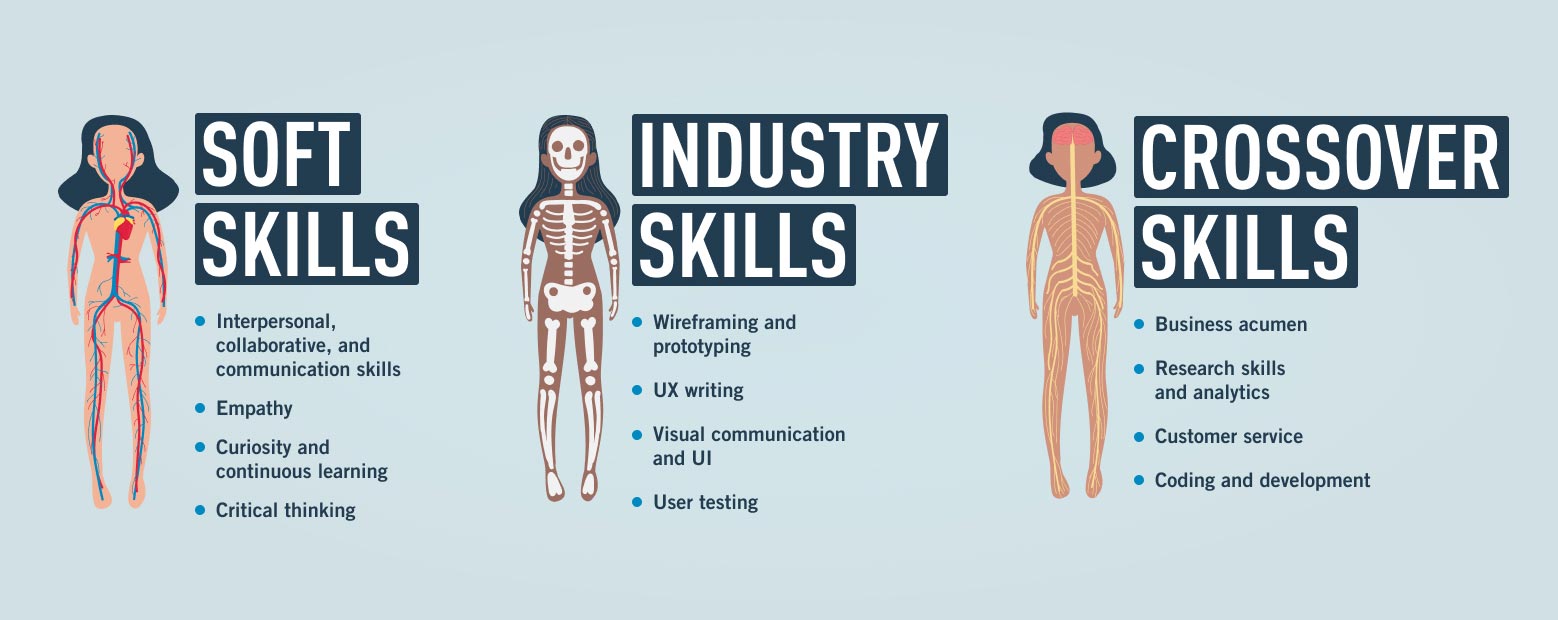What UX designer skills do you actually need to kick off a successful career in the field?
UX design is an incredibly diverse field full of designers with multi-faceted backgrounds and varying skillsets. With the growing popularity of careers in UX design, even with the most amazing UX design resume, it can be hard to determine how to best set yourself apart from other applicants when you’re trying to land a job.
Furthermore, since the position of “UX designer” can still be quite elusive to potential employers, it’s important that your skill set encompasses (and demonstrates) your full potential as a UX designer.
In addition to solid UX design skills, there are many other attributes UXers have that highlight their valuable position on a design team or within a company.
By the end of this article, you’ll have a good understanding of the different skills you’ll need to be a stellar UX designer and how you can go about acquiring them. There are many “soft” skills you’ll need alongside the industry standards expected of most designers.
In addition, we’ll highlight some skills you may carry over from other professional positions that have the potential to boost your worth as a UX designer.
Here are the skills we’ll touch on:
Soft skills
1. Interpersonal, collaborative, and communication skills
2. Empathy
3. Curiosity and continuous learning
4. Critical thinking
Industry-specific UX designer skills
5. Wireframing and prototyping
6. UX writing
7. Visual communication and UI
8. User testing
Crossover skills
9. Business acumen
10. Research skills and analytics
11. Customer service
12. Coding and development
For a brief video overview, here’s CareerFoundry mentor Tobias’s summary of important UX designer skills:
We’ve got a lot of skills to cover so let’s get started!
Soft skills
Soft skills often relate to personality traits, emotional intelligence, and situational awareness. These are non-technical skills that usually require little to no formal training, though it never hurts to brush up on them and discover tips and tricks for being even better at them.

1. Interpersonal, collaborative, and communication skills
Whether you’re working for a small start-up or a larger, multi-departmental company, there’s a good chance you’ll have to interact and collaborate with fellow colleagues, stakeholders, and clients on a regular basis.
Understanding how you work within a team setting and how you communicate with others will help determine what types of jobs you’ll want to apply for.
They may not seem it at first, but they are essential UX designer skills, as they’ll help show whether you’ll be a good addition to a team.
2. Empathy
Being able to put yourself in the shoes of your user is a vital part to becoming a skilled UX designer.
Having empathy for and understanding other people’s frustrations can make you better equipped at finding a solution for them—a crucial responsibility for any UX designer. Listening attentively to user feedback is a great way to understand the problem at hand in order to find meaningful and useful solutions to it.
If you’d like to learn more, we have a full guide to why empathy is a key UX designer skill.
3. Curiosity and continuous learning
UX designers are constantly searching for ways to improve the world around them. This continuous curiosity and desire to learn is an integral part of the profession.
UX designers must be willing to search for ways to enhance the lives of their users without necessarily telling them how. Boost your curiosity and learning skills by making a habit of listening more than you speak, looking at problems from multiple angles, and asking quality questions often.
4. Critical thinking
The Foundation for Critical Thinking defines critical thinking as “the process of actively conceptualizing, applying, analyzing, synthesizing, and/or evaluating information gathered from observation, experience, reflection, reasoning, or communication, as a guide to belief and action.”
Simply put, UX designers must be able to gather significant information and put it to use in a purposeful and relevant way. Ways to boost critical thinking skills include questioning basic assumptions, understanding your own mental processes, and developing superior foresight.
Industry-specific UX designer skills
Industry skills are specific to a career in UX and consist of important knowledge and abilities that all UX designers must hone and sharpen in order to be accepted as a quality designer.
Keep in mind that some of the skills we list here are specializations in and of themselves. But if you land a typical UX “generalist” role, or you land a job in a startup, you’ll need to have some skills in many of these areas.
5. Wireframing and prototyping
Wireframing and prototyping skills are at the core of the UX design profession. It’s unlikely you will come across a UX job that doesn’t require excellence in this area.
Your wireframes and prototypes are the best way to test your designs, catch mistakes or find ways to improve your product before it’s finalization. There are many online instructionals and budget-friendly tools you can play around with to improve your wireframing and prototyping skills.
6. UX writing
The language used within your designs can have a huge impact on your user’s experience when interacting with the product.
The way designers choose to phrase error messages, app instructions, onboarding pages, calls to action, and captions will determine how easy it is for consumers to navigate the interface and how likely they are to continue using it.
Brushing up your language skills and looking at great examples of microcopy can help improve your UX writing skills.
7. Visual communication and UI
A large percentage of the population are visual learners and are greater impacted by visual cues than auditory ones.
Understanding this fact and upping your UI skills can have a measurable effect on your designs.
Learning good visual communication, like making things look clickable, establishing effective visual hierarchy, using typography and color theory to your advantage, and limiting the need for written instruction are all important skills for UX designers to have.
8. User testing
Gathering quality information from your user’s as they interact with your product is one of the critical UX designer skills to develop.
Learning how to test and extract what your user’s needs are is crucial to creating a useful product. Observing the way people interact with your designs, what they like, dislike, or where they get hung up can help ensure your final product is exactly what your users are looking for.
Crossover skills
Many UX designers come from a variety of past professions. Crossover skills are things that you can bring to your UX career from previous occupations.
Don’t have past work experience? No worries, we’ll tell you how you can gain some expertise in these areas:
9. Business acumen
While you may not have gotten into UX design to discuss things like KPIs, assets, or profit margins, having a basic sense of how a business operates can make you a more well-rounded UX designer and a breeze to work with.
Knowing what goes on within the business side of the organization you work for can give you a better understanding of what your clients, colleagues, and consumers are experiencing. You can use this knowledge to better communicate with your team and ensure your designs are helping meet overall company goals. \
Taking a simple online course in corporate basics is an easy way to up your business acumen. To explore further in this direction, read this guide: What is UX Strategy?
10. Research skills and analytics
UX designers make tons of decisions all day long. Most of these decisions are carefully chosen and backed by hard data and research.
Some things UXers research may be who their target audiences are, what products similar to theirs are already in existence, how well their app or interface is being received, and how it could be improved. This is often done through online research, user testing and interviews, questionnaires, card sorting activities, and online software like Google Analytics.
11. Customer service
Having a background in or understanding general customer service practices can help make you a next-level UX designer.
Knowing how to address customer needs and satisfaction levels is paramount to being a successful designer. Customer service skills encompass things like active-listening, productive communication, good time management, adaptability, and quality problem solving.
12. Coding and development
There are times in a UX designer’s career when they must wear more than one hat, so to speak.
With the demand for tech-savvy designers increasing, knowing a bit about coding and development can be especially appealing to potential employers. Even if you’re not the one doing the coding and developing, being able to create development-friendly designs can help make your teammates’ jobs easier and make you a more alluring designer.
Browsing through some online resources can seriously up your understanding of coding and development. Taking a free short course in web development is a great way to start.
A final word
There’s a lot that goes into becoming a well-rounded and competitive UX designer. Alongside well-developed and heavily practiced industry skills, UX designers often hold competency in a wide variety of subjects that complement the profession.
Placing value in developing these auxiliary skills can not only boost your proficiency as a designer but can also help you stand out to potential employers as the demand for tech-industry workers increases.
As you can see, successful UX designers have a skillset that is incredibly diverse. And when you consider the fact that many UXers are developing specialized knowledge and experience in areas of interest (like UX research, UX writing, and voice user interface design), the sky’s the limit in terms of how far you can grow in your career as a UXer.
And how do you go about developing these UX designer skills? Before you go back to school for a design degree, there are a lot of free UX design resources out there, from books to UX design blogs and podcasts, and more.
But eventually, you’ll need to formalize your training to some extent. For that, you should check out some great UX certification programs.
The best UX courses are designed to take you from total beginner to expert in far less time (and for a lot less money) than most degree programs.
If you’d like to learn more about UX design, check out these articles:
